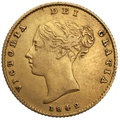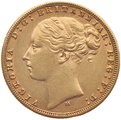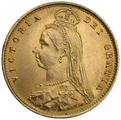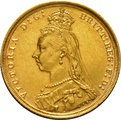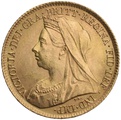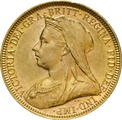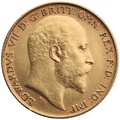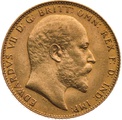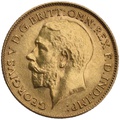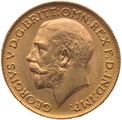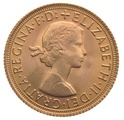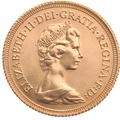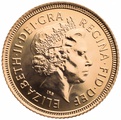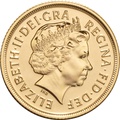Sovereign Mintages

Sovereigns are a popular bullion coin, and for many years they were a circulated currency in Britain and territories abroad. Valued at the equivalent of a Pound, gold Sovereign coins have been a trusted investment option for many years.
Some buy Sovereign coins for their additional numismatic interest however, whether due to the limited mintage figures from the Royal Mint for that particular year, or due to their exceptional condition.
Below we have compiled a detailed list of Sovereign and Half Sovereign production from 1817 until 2016. This data also includes some proof coin figures, where data was available. More modern figures will be updated as and when they become available from official sources.
Jump to a specific monarch by clicking one of the links below:
George III
|
George IV
|
William IV
|
Victoria
|
Edward VII
|
George V
|
George VI
|
Elizabeth II
Jump to a specific Mint location by clicking one of the links below:
Sydney (Australia) | Melbourne (Australia) | Perth (Australia) | Ottawa (Canada) | Mumbai (India) | Pretoria (South Africa)
Jump to a specific year by clicking one of the links below:
1817 - 1818 - 1819 - 1820 | 1821 - 1822 - 1823 - 1824 - 1825 | 1826 - 1827 - 1828 - 1829 - 1830 | 1831 - 1832 - 1833 - 1834 - 1835 - 1836 - 1837 | 1838 - 1839 - 1840 - 1841 - 1842 - 1843 - 1844 - 1845 - 1846 - 1847 - 1848 - 1849 - 1850 - 1851 - 1852 - 1853 - 1854 - 1855 - 1856 - 1857 - 1858 - 1859 - 1860 - 1861 - 1862 | 1863 - 1864 - 1865 - 1866 - 1867 - 1868 - 1869 - 1870 - 1871 - 1872 - 1873 - 1874 - 1875 | 1876 - 1877 - 1878 - 1879 - 1880 - 1881 - 1882 - 1883 - 1884 - 1885 - 1886 | 1887 - 1888 - 1889 - 1890 - 1891 - 1892 - 1893 | 1894 - 1895 - 1896 - 1897 - 1898 - 1899 - 1900 - 1901 | 1902 - 1903 - 1904 - 1905 - 1906 - 1907 - 1908 - 1909 - 1910 | 1911 - 1912 - 1913 - 1914 - 1915 - 1916 - 1917 - 1918 - 1919 - 1920 - 1921 - 1922 - 1923 - 1924 - 1925 - 1926 - 1927 - 1928 | 1929 - 1930 - 1931 - 1932 | 1937 - 1949 - 1951 - 1952 | 1957 - 1958 - 1959 - 1962 - 1963 - 1964 - 1965 - 1966 - 1967 - 1968 | 1974 - 1976 - 1978 - 1979 - 1980 - 1981 - 1982 - 1983 - 1984 | 1985 - 1986 - 1987 - 1988 - 1989 - 1990 - 1991 - 1992 - 1993 - 1994 - 1995 - 1996 - 1997 | 1998 - 1999 - 2000 - 2001 - 2002 - 2003 - 2004 - 2005 - 2006 - 2007 - 2008 - 2009 - 2010 - 2011 - 2012 - 2013 - 2014 - 2015 | 2016 - 2017 - 2018 - 2019 -

| Sovereign | Half Sovereign | |
| 1817 | 3,235,239 | 2,080,197 |
| 1818 | 2,347,230 | 1,030,286 |
| 1819 | 3,574 | None Issued |
| 1820 | 2,101,994 | 35,043 |
Background:
George III was the King of Great Britain and the King of Ireland between 1760 and 1801, at which point the two nations formed a union. George officially ruled the union until his death on January 29th, 1820, but his son - also George - acted as Prince Regent from 1811 due to the King's failing mental health.
Sovereign coins were once a currency unit in England, and were reintroduced by the Royal Mint and the Treasury as part of the 1816 Great Recoinage. Britain was struggling with debt and a shortage of coins due to the ongoing Napoleonic Wars, which led to the creation of the Sovereign - a slightly lighter coin than the existing gold Guinea.
The gold Sovereign returned in 1817. Italian sculptor Benedetto Pistrucci designed the coin, creating the classic St George & Dragon design that is still used to this day. He also produced the portrait of King George, often referred to as the 'bull head George'. These coins had a notably thick border.

Laureate head:
1821 - 1825
|
Bare head:
1825 - 1830
*includes both obverse designs due to transition period
Background:
King George IV started his rule as the Prince Regent, deputising for his ill father. Following George III's death in 1820, George was crowned as his successor and the fourth of his name. The king was unpopular due to his lavish lifestyle and boisterous ways, with many labelling him irresponsible and unreliable.
The thick border of the George III Sovereigns was abandoned, allowing for a larger portrait of the King. George also commissioned another redesign for the gold coins, wanting to move away from Pistrucci's St George design. In 1825, the Royal Mint began a transition period from the laureate (wreathed) head of George IV with St George, to a more modest bare head obverse with a shield back design on the reverse portraying the royal coat of arms.

| Sovereign | Half Sovereign | |
| 1831 | 598,547 | None Issued |
| 1832 | 3,737,065 | None Issued |
| 1833 | 1,225,269 | None Issued |
| 1834 | None Issued | 133,899 |
| 1835 | 723,441 | 722,554 |
| 1836 | 1,714,349 | 146,865 * |
| 1837 | 1,172,984 | 160,207 |
* + additional rarities produced by the Royal Mint using the Sixpence die for the obverse side
Background:
William was the third son of George III, and succeeded his brother George IV in 1831. William was the third child of King George III and Queen Charlotte, as well as the third son. His older brother Frederick was a senior figure in the British Army and, unlike the eldest brother George, very well respected. Frederick died in 1827 to a swelling condition known as 'dropsy', and as such William became the heir to the throne.
Akin to George IV before him, William IV had two different gold Sovereign coins issued during his reign. Both types kept with the 'Shield Back' design that George had introduced, but instead had slightly differing portraits of King William; one with a furtive look, and one more peaceful.
Collectors are keen on William's reign due to the unknown number of proof Sovereigns made during this period.

'Shield Back'
&
Young head:
1838 - 1887
|
Jubilee head:
1887 - 1893
|
Old head:
1893 - 1901
Queen Victoria reigned as Queen of the United Kingdom of Great Britain and Ireland from June 1837 until her death in January 1901. In 1876 she also became Empress of India. Until our present monarch, Victoria was the longest-reigning ruler in British history. Her lifespan led to the era being dubbed the Victorian Age, with massive industrial and social change occurring in the UK, all while Britain expanded its colonial ambitions across the world with the British Empire.
In 1854, due to the prevalence of gold in Australia, the Royal Mint opened up its first refinery outside of the British Isles. The site, in Sydney, would allow gold mining in Australia to save on transportation time and cost in getting the gold refined and coined. The Sydney refinery produced Sovereign coins until 1926.
View our full range of Sovereigns minted in Sydney.
* Coins issued by the Sydney Mint in 1869 were dated 1868
In 1872, thanks to the success of the Sydney Mint, the Royal Mint granted permission to another franchise refinery to open in Australia - this time in Melbourne. The site had originally bid against Sydney in 1854 to create the first refinery, but narrowly missed out. The Melbourne site would continue production until 1931.
View our full range of Sovereigns minted in Melbourne.
Jubilee head Victoria Sovereigns:
In 1887, the Royal Mint updated Queen Victoria's portrait on Sovereign coins to better reflect her age. After all, she was no longer a teenage monarch. The new design was released in time for Victoria's golden jubilee and production ran for seven years.
The Royal Mint updated Sovereign coins once more during Queen Victoria's reign, in 1893. Her husband, Prince Albert, has passed away in 1861 from typhoid fever, though the Prince had been battling an unknown stomach condition for some years prior. In her grief, Victoria took to wearing only black, and a permanent veil to mark her mourning. She was significantly more reclusive during this period, and performed less public duties and appearances.
Eagle-eyed readers will notice that production of the Jubilee head and Old head overlapped in 1893. The Royal Mint (for the most part) alternated production between types and refinery sites.
Just before Queen Victoria's death and the end of a record-long tenure as monarch, the Royal Mint opened one final refinery in Australia - this time in the far west. The Perth refinery was near many of Australia's largest gold fields - fields which are still mined today - and following Australia's independence from the British Empire, the refinery became the private Perth Mint; an LBMA-approved gold refiner from whom we stock gold and silver coins here at BullionByPost.
View our full range of Sovereigns minted in Perth.

Background:
Edward was the eldest son of Queen Victoria and Prince Albert. Due to Victoria's then-record reign as monarch, Edward set a new record for longest time as the Prince of Wales. Edward performed ceremonial tasks as a Prince, and was widely considered something of a playboy - a moniker which soured relations between him and his mother.
Following the death of Victoria, Edward was crowned King. His birth name was officially Albert, but he chose to use Edward so as not to devalue the name and accomplishments of his father.
King Edward VII, as he was officially known, only had one variety of Sovereign coin modelled upon himself.
In 1908, the Royal Mint's expansion continued - this time to Ottawa, Canada. The move was designed to help with debt-settlement between Britain and the US Treasury. Gold Sovereigns were shipped to Canada for smelting down and refining into ingots that the United States could use. The Royal Canadian Mint refinery opened, having been designed as an homage to Windsor Castle, but it also produced a small quantity of Sovereigns itself. The building still headquarters Canada's national mint to this day, though the company has a second, more modern refinery in Winnipeg.

Standard head:
1911 - 1928
|
Small head:
1929 - 1932
Background:
George was the second son of Edward VII, and became heir to the throne following the death of his older brother, Prince Albert Victor. Albert was engaged to Princess Mary of Teck, but died following a flu pandemic. Instead, Princess Mary married the younger brother George, and they had six children.
During George V's reign, the outbreak of the First World War heavily impacted upon British society. Anti-German sentiment was high, leading King George to rename the royal house to become the House of Windsor, rather than the existing House of Saxe-Coburg and Gotha.
* Outbreak of the First World War | Suspension of the Gold Sovereign as circulated currency
The Royal Mint expanded - albeit briefly - to Bombay (now Mumbai) in India as part of a push to increase output during the ongoing 'Great War'. The Indian refinery began production in August 1918 and ran until early 1919, with the conclusion of the First World War in November 1918 removing the need for a refinery in India.
Sovereign coins would now not be minted in London until 1925, while Half Sovereigns would not be issued again in Britain during George V's reign. Half Sovereign coins in general were not issued at any Royal Mint site until 1925, and production only lasted for two years.
A year after India stopped producing Sovereigns, the Ottawa refinery in Canada also ceased operation. The mint stayed active, however, and simply passed over to the Canadian authorities for domestic production.
| Sovereign (Sydney) | Sovereign (Melbourne) | Sovereign (Perth) | Sovereign (Canada) | |
| 1919 | 1,835,000 | 514,257 | 2,995,216 | 135,957 |
| Sovereign (Sydney) | Sovereign (Melbourne) | Sovereign (Perth) | |
| 1920 | 514,257 | 530,266 | 2,421,196 |
| 1921 | 839,000 | 240,121 | 2,314,360 |
| 1922 | 578,000 | 608,306 | 2,298,884 |
In 1923, the Royal Mint expanded to one last new location. This site was to be in South Africa, with a new refinery established in Pretoria. The mint would operate until 1932, at which point it was turned over to local authorities. It is now better known as the Rand Refinery, and produces Krugerrand coins for the South African government.
The 1925 issue of the Gold Sovereign was particularly special, as the coin die - used to stamp the pattern into the gold - was kept by the Royal Mint and used (arguably lazily) again in 1949, 1951 and 1952.
The Sydney mint ceased production in 1926, with South Africa taking the lead in terms of production quantities for the Royal Mint and the British Empire as a whole.
| Sovereign (Melbourne) | Sovereign (Perth) | Sovereign (South Africa) | |
| 1927 | 310,156 | 1,383,544 | 16,379,704 |
| 1928 | 413,208 | 1,333,417 | 18,235,057 |
A slightly smaller headed Sovereign was issued for the final three years of coin production under George V, with the Royal Mint ceasing production between 1933 and 1936. During this time, production was halted in Melbourne and Perth, with Pretoria following shortly after.
| Sovereign (Melbourne) | Sovereign (Perth) | Sovereign (South Africa) | |
| 1929 | 436,938 | 1,607,625 | 12,024,107 |
| 1930 | 77,588 | 1,915,352 | 10,027,756 |
| 1931 | 57,809 | 1,173,568 | 8,511,792 |
| Sovereign (South Africa) | |
| 1932 | 1,066,680 |
GEORGE VI : 1937, 1949, 1951 - 1952

.
| Sovereign (London) | |
| 1937 | 5,500* |
| 1949 | 138,000** |
| 1951 | 318,000** |
| 1952 | 430,000 ** |
* Coins issued in 1937 were part of a four-coin Sovereign set
** 1925 re-strikes using the George V Sovereign die
Background:
George VI was born Albert Frederick Arthur George. He was the second son of George V and Mary of Teck. His older brother, Edward, was the heir to the throne but abdicated to marry Wallis Simpson; a divorcee who was in the process of her second divorce.
King George was a reluctant king, and a more introverted individual than previous monarchs. He famously admitted in his diary of speaking to his mother and breaking down in tears about the fact he was to become the monarch. His shy nature and severe stammer became the subject of the 2010 film 'The King's Speech'.
Very few Sovereigns were issued during the reign of George VI, with even less of the Half Sovereign coins minted. Coins issued in 1937 were done so as part of a four-coin Sovereign set to commemorate George VI's coronation, while coins produced in 1949, 1951 and 1952 used the 1925 die. This means that the latest gold coins issued by the Royal Mint in George VI's reign actually depicted his father, George V.

Young head: 1957 - 1959, 1962 - 1968 | Decimal head: 1974, 1976, 1978 - 1984
Third head:
1985 - 1997
|
Fourth head:
1998 - 2015
|
Fifth head:
2016 - Present
Background:
Elizabeth II became Queen in 1952 following the death of her father, King George VI. Unsurprisingly, the young Queen chose to stick with her birth name as her regnal (ruling) name, but more surprising was the refusal to change the royal household from the House of Windsor to the House of Mountbatten or the House of Edinburgh - in keeping with the tradition of the wife taking the husband's family name.
Queen Elizabeth is the longest-serving British monarch, the longest serving female head of state in the world, and the oldest current monarch. The Royal Mint has issued five different heads for coins such as the Sovereign, with the latest issue by Jody Clark expected to be the last (bar any commemorative designs in the future).
Young head Elizabeth Sovereigns:
The first Sovereign coin to bear Elizabeth's face on the obverse came in 1957 - five years after her ascension to the throne and four after her coronation. The coin featured an appropriately young Elizabeth, and was designed by Mary Gillick.
| Sovereign (London) | |
| 1957 | 2,072,000 |
| 1958 | 8,700,000 |
| 1959 | 1,385,228 |
| 1962 | 3,000,000 |
| 1963 | 7,400,000 |
| 1964 | 3,000,000 |
| 1965 | 3,800,000 |
| 1966 | 7,050,000 |
| 1967 | 5,000,000 |
| 1968 | 4,203,000 |
Decimal head Elizabeth Sovereigns:
Sovereign production ceased once more, with the approach of decimalisation. British currency switched from the old imperial system to metric on 'Decimal Day' - February 15th, 1971. The Royal Mint resumed production of Sovereigns and Half Sovereigns but with a new portrait of the Queen; a move designed to highlight the change in Britain's coinage, but also better reflect the Queen, who was now 17 years older than her previous portrait. This portrait was designed by Arnold Machin.
Royal Mint Llantrisant:
It was during this transitional decimalisation period that the Royal Mint drew up plans for expansion. The Tower mint in London had always been short of space. The move from the Tower of London to the Tower Hill site had been for expansion purposes, and once again the Mint needed to grow in order to handle the change in circulated and non-circulated coinage. A new site was chosen in South Wales in the small town of Llantrisant, and the first Sovereign coins were minted there in 1976.
* One Sovereign coin was minted in 1975 as the final issue from the Tower Hill site in London before closure
** Includes Half Sovereigns in three or four-coin Sovereign sets
Third head Elizabeth Sovereigns:
Between 1983 and 1997, Sovereign coins were only issued in proof format - regardless of the size of Sovereign. Proof mintages issued by the Royal Mint for this period account for coins included in coin sets.
A more mature portrait of the Queen was chosen by the Royal Mint for the Sovereign coins, as designed by artist Raphael Maklouf.
* Proof Sovereigns issued in 1989 marked the 500th anniversary of the original English Sovereign, and depicted
Queen Elizabeth II in the same portrait fashion as Elizabeth I on the obverse, with a large Tudor rose on the reverse.
Fourth head Elizabeth Sovereigns:
Perhaps the most recognisable portrait of Queen Elizabeth II was put into use in 1998 by the Royal Mint and the Royal household in general. Ian Rank-Broadley designed an older portrait of Elizabeth to more realistically portray her age, but also the significant position she held in British society as one of the longest ever reigning monarchs. The first two years of production continued to be proof-only, but in 2000 the Royal Mint decided to restart bullion Sovereign production.
| Proof Sovereign | Proof Half Sovereign | |
| 1998 | 11,349 | 6,147 |
| 1999 | 11,903 | 7,500 |
.
* Queen's Golden Jubilee, celebrating 50 years on the throne
+
A one-off design of Sovereign, as produced by Timothy Noad
x
Proof figures from here onwards include coins in Sovereign collection sets
#
A one-off design of Sovereign, as produced by Paul Day
Fifth head Elizabeth Sovereigns:
The fifth and likely final head of Elizabeth II was introduced in 2016 to all Royal Mint coins. Designed by Jody Clark (one of the Royal Mint's own design team), it was the first time in the Mint's long history that a staff member had been chosen to design a Sovereign coin. Clark has since gone on to design many of the Queen's Beast series, amongst other Royal Mint coins.
Please note:
Due to the recent issuing of these coins, official Royal Mint figures on output are scarce. These figures will be updated as and when information becomes available.
* 2016 proof Sovereigns featured a unique obverse portrait to commemorate the Queen's 90th birthday, as designed by James Butler
Disclaimer:
The above Sovereign mintage figures are based on several methods of research and are not guaranteed to be 100% accurate. If you notice an incorrect figure, or have an updated number, please email support@bullionbypost.co.uk and your query/suggestion will be directed across to our writing team.
References:
Thanks goes to the Royal Mint for their historic mintage figure data, as well as to the following sources:
The Gold Sovereign by Michael A. Marsh & The Gold Half Sovereign by Michael A. Marsh
Coins of England & the United Kingdom (Pre-Decimal Issues) by Spink & Coins of England & the United Kingdom (Decimal Issues) by Spink
- How To Buy Gold
- How to Buy?
- Payment Options
- Delivery Options
- Gold Storage
- Storage at Brink's
- Gold Investment Guide
- Why buy gold?
- Is gold a good investment?
- Why physical gold?
- Best time to buy gold?
- Gold bars vs coins?
- Gold vs Silver
- Gold - Silver Ratio explained
- VAT on bullion
- CGT on bullion
- Legal tender coins
- Top 5 Gold Investments
- Top 5 Silver Investments
- Gold vs ISAs
- Gold vs Buy-to-Let
- Gold vs FTSE 100
- Gold vs Bitcoin
- Where to buy gold?
- Why buy from us?
- Where to sell gold?
- Coin Shops
- Gold Price Forecasts
- Top 10 Gold Producers
- Top 10 Gold Reserves
- Gold Britannia vs Sovereign
- Britannia coin designs
- Sovereign coin designs
- Sovereign Mintages
- Sovereign mint marks
- British coin specs
- What is a proof coin?
- Royal Mint bullion
- The Queen's Beasts
- Royal Mint Lunar Coins
- Bullion Refiners
- British coin mints
- Krugerrands
- Gold Tola - India & Pakistan
- Bullion Index






